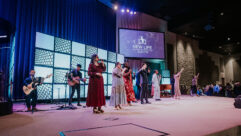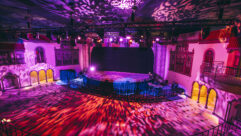Bringing A Dead Auditorium Back To Life
Vestal High School in upstate New York looks in its own backyard and Japan for help with an acoustically challenged auditorium.
Vestal High School’s decades-old auditorium got a major acoustical makeover with the help of AVL Designs, architect Bearsch Compeau Knudson and Yamaha Commerical Audio. Among AVL’s tasks: acoustical correction and a new audio system.
Credit: Yamaha Commerical Audio
CHALLENGE: Overhaul the acoustics in a 1959 high school auditorium that was once called “the deadest room I had ever been in.”
SOLUTION: Install more than a dozen different products, including resonator panels, underbalcony loudspeakers, wireless mics, and two consoles.
WHEN VESTAL HIGH SCHOOL’S auditorium was built, Fidel Castro had just taken power, Alaska and Hawaii had finally become states, and Texas Instruments was still developing the first integrated circuit. The latter came in handy nearly a half-century later, when the Broome County, N.Y., auditorium got a major renovation to address a litany of acoustic shortcomings.
“The stage and front of the auditorium were very poor acoustically, and if you sat beneath the balcony, sound was almost nonexistent,” says Dennis Powell, a senior director in the school’s music department. “Even with our previous sound system, it was difficult to hear many things and very hard to balance. Just imagine an auditorium with no built-in speakers of any kind, and flat sidewalls with no reverberation whatsoever. It was the deadest room I had ever been in.”
The job of fixing those problems went to acoustical consultant AVL Designs, architect Bearsch Compeau Knudson in nearby Binghamton, N.Y., and Yamaha Commercial Audio. AVL’s tasks included acoustical correction and a new audio system.
“The existing space had a lack of lateral energy, a resonance in the 150 Hz to 250 Hz region, flutter echoes, and an RT60 too low for some forms of music,” says Seth Waltz, president of AVL of Penfield, N.Y.
The Vestal project also was saddled with a problem as old as the auditorium itself: a limited budget of only $630,000.
“The budget was tight and had to include acoustics, audio, stage rigging, and lighting upgrades,” says Waltz. “Musical quality and audio system performance were given top priority but had to be accomplished with very tight budget constraints.”
The Vestal’s High School auditorium uses Yamaha’s Acoustical Field Correctional system to provide control over the reverb time decay. The system includes four presets to tailor the reverb for each performance type: choral, orchestral, chamber, music, and jazz ensemble, whose pattern enhances loudness and realizes high clarity. These presets are created during the tuning process, and correspond to changes in the reverberation time curves.
Other challenges included ensuring that the overhaul didn’t make the space less user friendly or too rigid to accommodate the variety of performance types found in a high school auditorium. In fact, the latter was particularly important, because the auditorium is the only one in the district large enough to accommodate any of the schools’ rehearsals and performances. As a result, more than 40 district groups share the space.
“The biggest challenge was finding a way to provide variable acoustics for the multiple musical uses of the space, yet with a simple interface for users,” says Lon Brannies, consultant and AFC marketing manager at Yamaha Commercial Audio. “The use of minimal physical acoustical work, and cost-effective yet sonically excellent equipment, helped meet the budget.”
Room for Improvement
AVL tackled the 850-seat auditorium with a variety of products. One was Helmholtz resonator panels, which were used to correct the difficult room mode around 250 Hz.
“We tuned out the resonance and diffused some negative reflections in the room with a Helmholtz implementation of RPG Diffusors’ ‘Flutterfree,’ built over custom wall cavities,” says Waltz.
IMPLEMENTING YAMAHA’S AFC SYSTEM
Twenty Yamaha S8AFC-D loudspeakers are flush mounted into the ceiling and concealed with standard, perforated metal grills.
The Vestal High School auditorium uses Yamaha’s Acoustical Field Correction (AFC) system, which features 20 loudspeakers: the Yamaha S8AFC-D, which is an 8-inch coaxial unit with a soft dome tweeter.
“This particular model is the driver-only version, and was mounted on a circular ceiling grill,” says Lon Brannies, consultant and AFC marketing manager at Yamaha Commercial Audio.
Vestal also used four Audio-Technica ES945 boundary mics, located in a straight line in front of the stage proscenium and mounted in a small hole in the ceiling. “On some of these smaller jobs where the budget is really tight, we’ve been using the Audio Technicas,” says Seth Waltz, president of Penfield, N.Y.-based AVL, who adds that they still provide good results.
The microphones feeding the AFC system connect to a proprietary Yamaha processor.
“The system is intentionally put into regenerative feedback,” says Brannies. “The DSP is adjusted so it doesn’t allow the feedback to get to the full howling point, but the reverberant energy created by the near feedback point remains in the room. The DSP also allows extending the reverberation tail a little bit.”
This process is designed to extend the reverberation time and prevent howling. The tuning process allows some adjustment to the reverberation time curve.
“The shortest time is always the natural reverberation time curve of the room with the system off,” says Brannies. “The longest time is set at the discretion of the acoustician conducting the tuning process and also depends on the type of programs in the hall.”
For an overview of Yamaha’s recommendations for loudspeaker placement in AFC systems, visit www.yamaha-afc.com/system/loudspeakers.html. The company has mic guidelines at
www.yamaha-afc.com/system/microphones.html.
AVL chose Yamaha’s Acoustical Field Correction (AFC) solution to provide control over the reverb time decay in the 175,500-cubic-foot auditorium. Vestal now has four presets, accessed from stage right and the booth via the Crestron control, to tailor the reverb for each performance type:
Choral, where Yamaha says the sound is “bright with clear, high frequencies.”
Orchestral, where the bass sound was lengthened to produce “a richer warmth than other patterns,” as well as “high spaciousness.”
Chamber music, which has the same characteristics as orchestral but with reduced room size.
Jazz ensemble, whose pattern “enhances loudness and realizes high clarity.”
“The various presets are created during the tuning process and correspond to changes in the reverberation time curves,” says Brannies.
AVL chose the AFC system after hearing a demo.
“We were impressed by how natural the system response was, even in a small space,” says Waltz. “The sense of envelopment generated even by overhead sound sources was impressive, as well as the density of the reflections. At Vestal, we used overhead loudspeakers exclusively for the AFC system, yet achieved a good sense of lateral energy due to the excellent tuning by the Yamaha field personnel.”
The renovation also added two large loudspeakers above the front of the lower-level seats, plus more in the ceiling underneath the balcony and two rows above the balcony. For the main loudspeakers, AVL chose Eastern Acoustic Works’ (EAW) AX series because of their three-way point-source design.
“These were located to blend with energy arriving from the stage, as well as the AFC sources,” says Waltz. “The AX speakers are very ‘in phase’ by design, so they integrate well into an acoustic sound field. The AFC system uses many small [Yamaha S8AFC-D] loudspeakers to create the sound field. The microphones feeding the AFC run into a proprietary Yamaha processor.”
Despite its limited budget, Vestal was able to afford the AFC system, which it selected during a competitive bidding process.
“If I were making a budget estimate for this size project today, I would estimate a turnkey price to the owner for the AFC part only at about $218,000,” says Yamaha’s Brannies. “Markup by the general contractor will add 15 percent or more, depending on how the system falls into the bid spec.”
AVL also chose EAW’s MK8196v for over the balcony, while the problematic underbalcony area is covered with Tannoy i6AW loudspeakers. Ashly Audio’s Protea 24.24M Matrix Processor handles Vestal’s speaker processing. The system uses a modular design with expansion cards to support up to 24 channels.
One of Vestal’s two new consoles is a Yamaha 01V96V2, which AVL chose partly because it allows preset configuration changes for many types of musical events, and partly because it’s a good fit for an educational environment.
“The 01V96V2 sound quality is exceptional for a console in this price class,” says Waltz. “It has enough processing depth to teach digital mixing techniques, yet is easy enough for novice users.”
The other new console is a Mackie Onyx series console, which was brought in so Vestal students could learn both analog and digital mixing techniques — a training opportunity for the next generation of AV pros. The Onyx also can be used as a submixer into the Yamaha 01V96V2. Rounding out the system is a Crestron controller that’s interfaced to the Yamaha 01V96V2, the AFC, and the Protea. QSC PLX series amplifiers provide system power.
So Far, So Good
Although the Vestal project was completed in October 2006, the school already has good things to say about the makeover.
FOR MORE INFORMATION
- Ashly Audiowww.ashly.com
- Audio-Technicawww.audio-technica.com
- Crestron Electronicswww.crestron.com
- Eastern Acoustic Workswww.eaw.com
- Mackiewww.mackie.com
- QSC Audio Productswww.qscaudio.com
- Tannoywww.tannoy.com
- Yamaha Commercial Audiowww.yamaha-afc.com
- Sennheiserwww.sennheiser.com
- Countryman Associateswww.countryman.com
- RPG Diffusor Systemswww.rpginc.com
“As we are getting more used to the abilities of this system, the more I am amazed at what it can do,” says Powell. “The enhancement system evens out all sound production, as well as truly giving the audience a quality and well-balanced listening experience. We just finished putting on ‘West Side Story,’ and I have never had such a fine product with sound before.”
That musical used 17 Sennheiser EW Series wireless mics: eight lavaliers models, and nine with Countryman E6 around-the-ear units with their own receivers.
“The audience heard every line and song with amazing clarity,” says Powell. “The orchestra could play at a normal level as well.”
So far, the new equipment has proven to be an equally good fit for performers and audiences alike.
“I would endorse this whole system completely,” says Powell. “We are still finding out it totally works with all of our groups. I have a 16-voice jazz choir who each use a mic, and we are just getting to try these out. But the little we have done indicates the system will be very successful for this as well. The clarity, balance of highs and lows, and the lack of feedback are especially impressive. The enhancement part of the system has worked very well at this point. It was a great add to the rest of the system.”
Tim Kridel is a freelance writer and analyst who covers telecom and technology. He’s based in Columbia, Mo., and can be reached at[email protected].









